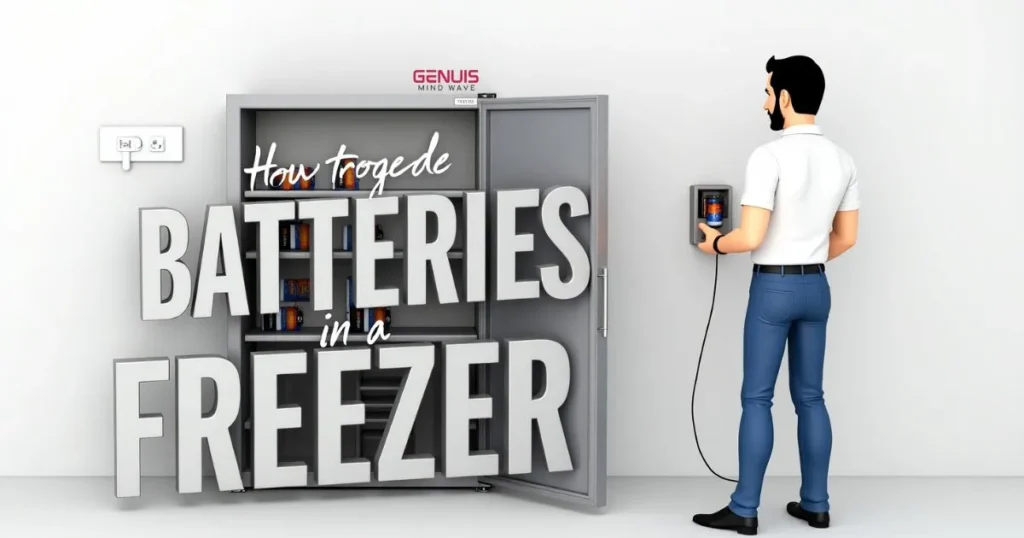The concept of how to recharge AA batteries in a freezer is fraught with uncertainty, differing opinions, and concerns. Don’t worry if you’re experiencing issues with your frozen batteries. This article discusses common reasons and strategies for getting back on track. Some claim this battery freezing technique improves battery life, while others warn against serious risks. This post dives deep into the facts, myths, and technical details you need to know.
What Is the Freezer Battery Method?
Surprisingly, the freezer battery method isn’t new. Some early adopters believed that storing or cooling batteries at low temperatures helped reduce internal resistance within the battery. This led them to think about how to recharge AA batteries in a freezer would improve performance and extend charge retention. While the idea sounds logical, it doesn’t apply to all rechargeable battery types.
Older NiCd and NiMH batteries sometimes benefit from short-term cooling. However, the risk of lithium-ion battery freezing is very real and often leads to internal battery damage. Cooler temperatures cause the chemical reaction in batteries to slow down. That means you see improved performance only under particular conditions. Therefore, understanding the right approach to how to recharge batteries in a freezer is crucial before attempting this method.
.
Which Battery Types Can Handle Cold?
Now, let’s discuss the facts about cold battery charging. Not all batteries react the same way to being frozen. That’s why you must consider the type of battery before using any how to recharge AA batteries in a freezer.
NiCd and NiMH batteries sometimes exhibit minor lifespan improvements when cooled. But the benefits are marginal. Cold exposure can sometimes cause these batteries to reset their memory, restoring lost capacity. On the other hand, lithium-ion and lead-acid batteries do not perform well.
Freezing can cause edema, leaking, and an irreversible loss of capacity. The battery storage temperature for lithium-ion cells should always be above freezing. Otherwise, you’re inviting risk and potentially voiding your battery warranty. Thus, understanding the risks is essential before attempting how to recharge AA batteries in a freezer.
How to Perform Freezer Charging Safely
If you still want to try this method, follow proper battery maintenance techniques.
The first rule is always to handle batteries safely. Directly charging a cold battery is never a good idea. Please wait until it returns to room temperature first.
Ensure the batteries are entirely discharged before freezing. This lessens the chance of batteries corroding due to moisture. Before freezing, always place the batteries in a tightly sealed plastic bag. This shields them from ice crystals and humidity. Allow them to rest in the freezer for 4 to 6 hours. Afterward, give them enough time to reach room temperature charging conditions before using a compatible battery charger. These steps for charging batteries are crucial for preventing accidents. Therefore, if considering how to recharge batteries in a freezer, proceed only with caution and full understanding of the process.
Battery Freezing Risks and Safety Issues
There are numerous risks associated with this approach. The biggest threat is the risk of battery condensation. Corrosion of the interior components occurs if water gets into the battery case. That shortens the freezing battery life rather than extending it.
Another issue is the freezing of lead-acid batteries, which can cause irreversible damage. When frozen, their liquid electrolyte expands, causing the case to shatter. Additionally, there are strict safety regulations for batteries used in modern consumer electronics, particularly those based on lithium. Freezing them often leads to reduced capacity or thermal battery behavior issues. Thus, while some may still search for how to recharge batteries in a freezer, it’s clear that the risks far outweigh any potential benefits.
Why Manufacturer Guidelines Matter
Following the instructions provided by the battery maker is not only wise, but also required. Batteries are manufactured with particular performance ranges and limitations in mind. Breaking these can result in malfunctions and nullify warranties. Although cooling battery systems are used in large-scale setups, they’re nothing like storing a battery in your freezer. Hence, when it comes to how to recharge batteries in a freezer, always proceed with caution and prioritize manufacturer guidelines over informal methods.
Table: Battery Types vs Freezer Suitability
| Battery Type | Freezer Charging Suitability | Notes |
| NiCd (Nickel-Cadmium) | Moderate | It may help reset memory |
| NiMH (Nickel-Metal) | Moderate | Similar to NiCd, a slight improvement |
| Lithium-Ion | Poor | Risk of swelling, damage, and capacity loss |
| Lead-Acid | Poor | Can freeze and crack casing |
Case Study: Cold Storage Effect on Batteries
In one test, NiCd batteries were discharged and stored in a freezer for 6 hours. After warming to room temperature, they were recharged using a compatible battery charger. The performance improved slightly for a few cycles. However, when the same was done to lithium-ion cells, damage to the battery occurred.
This test confirms that the charging temperature range matters. Rechargeable energy cells are engineered for specific environments. Energy storage systems used in industry have sensors and regulation. But the home how of recharging batteries in a freezer lacks any control. Consequently, what works in a controlled setting may lead to failure or danger in a household scenario.
Industry News and Trends
Energy storage systems are experiencing a period of tremendous growth. Engineers now use advanced cooling battery systems in electric vehicles and grid storage. These regulate heat, not cold. New materials also reduce thermal battery behavior issues without freezing. Experts say that modern batteries are already optimized for safety, speed, and reliability.
Manufacturers emphasize keeping to their specs. Innovations target high performance, not DIY freezing methods. It’s best to let the pros handle performance tuning while you stick with what works.
Expert Opinion From Redway Battery
“While some users believe the recharging battery process in freezers can enhance performance, it is crucial to understand that modern rechargeable energy cells are engineered for optimal function at room temperature,” says a Redway Battery technician. “Always put battery efficiency advice and electrical safety procedures ahead of unproven tricks.
Conclusion
Although it is a safe option, charging batteries in the freezer is a dangerous practice. It can help cool NiCd or NiMH batteries down for a short time. What about batteries that employ lithium-ion or lead-acid? Please don’t approach it at all. You could shorten the equipment’s lifespan, damage it, and void its warranty if you do this.
Don’t take shortcuts; instead, opt for high-quality battery chargers that are compatible with your devices and follow the safety guidelines provided with them. Remember that scientifically proven methods of battery maintenance are always preferable to outdated, incorrect theories. And when it comes to extending battery performance improvement, smarter always beats colder.
Therefore, when considering how to recharge batteries in a freezer, understand the risks involved and choose safer, manufacturer-recommended alternatives.


